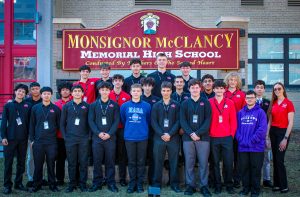
Quinten Jansen
A group of 30 high school students from Monsignor McClancy Memorial High School,
recently had the experience of visiting the NASA Wallops Flight Facility in Virginia, the
only NASA-owned facility of its kind in the state. The trip marked the culmination of a four-
year journey that began with a classroom project measuring the tree height using various
NASA techniques, and ended with recognition and a chance to see science come to life.
The project began during the students’ freshman year under the guidance of the STEAM
Faculty coordinator Deanna Danke and with support from Brian Campbell, Senior Earth
Science Specialist and GLOBE Observer Trees Science Lead at NASA Wallops and GST,
Inc. Initially met with confusion especially on how math applied to tree measurements, the
students quickly discovered the real-world application of their studies. Using NASA’s
satellite-based methods, they measured the height and diameter of local trees to assess
environmental health and sent their data to NASA. They thought little of it until a paper was
published in June 2022 featuring their work.
NASA later invited them to create a digital reel about their research. The students kept in
close contact with NASA over the next four years, which eventually led to their trip to the
Wallops Flight Facility.
Senior Richard Stock IV, who joined the project later, said, “I found the project really
exciting. Everyone had their own role, and it felt great to contribute.” He was especially
fascinated by how NASA uses lasers to study precipitation and climate change. Chris
Georgeopoulos was captivated by the NASA balloons. “The ropes can carry up to 8,000
pounds. They send up cameras and microphones 30 miles into the atmosphere.” he said.
Sophomore Joseph Werner recalled a school presentation on climate change, where they
linked tree health to environmental conditions. He recommends the program to others for its
real-world learning. Thiago Costa, initially uninterested, discovered a passion through the
project. “Now I know what I’m interested in,” he shared.
For Jake Wood, the turning point was learning about NASA’s ICESat-2, which uses lasers to
map land and sea ice every 90 days. Santiago Uribe-Correro, inspired by Campbell’s
leadership, credited him with bringing the whole experience together.
The opportunity wasn’t always guaranteed. These seniors only learned of the trip during their
final year. Students like Brandon, were drawn by the chance to see rockets and to learn how
radar detects precipitation. Sebastian Leonowicz, who hopes to pursue engineering, loved
seeing the rocket assembly process firsthand. “I was expecting a lot, and NASA delivered,”
he said.
Through it all, these students not only learned math in a hands-on, meaningful way, they
shaped the direction of their own learning and saw how their efforts connected to global
scientific work. What started as a simple class project turned into a powerful journey fueled
by curiosity, collaboration, and a bit of rocket science.


